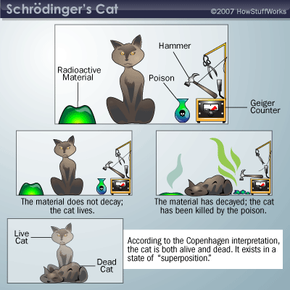The Copenhagen Interpretation
The Many-Worlds theory of quantum mechanics supposes that for each possible outcome of any given action, the universe splits to accommodate each one. This theory takes the observer out of the equation. No longer are we able to influence the outcome of an event simply by observing it, as is stated by the Heisenberg Uncertainty Principle.
But the Many-Worlds theory turns a widely accepted theory of quantum mechanics on its ear. And in the unpredictable quantum universe, this is really saying something.
Advertisement
For the better part of the last century, the most accepted explanation for why the same quantum particle may behave in different ways was the Copenhagen interpretation. Although it's getting a run for its money from the Many-Worlds interpretation lately, many quantum physicists still assume the Copenhagen interpretation is correct. The Copenhagen interpretation was first posed by physicist Niels Bohr in 1920. It says that a quantum particle doesn't exist in one state or another, but in all of its possible states at once. It's only when we observe its state that a quantum particle is essentially forced to choose one probability, and that's the state that we observe. Since it may be forced into a different observable state each time, this explains why a quantum particle behaves erratically.
This state of existing in all possible states at once is called an object's coherent superposition. The total of all possible states in which an object can exist -- for example, in a wave or particle form for photons that travel in both directions at once -- makes up the object's wave function. When we observe an object, the superposition collapses and the object is forced into one of the states of its wave function.
Bohr's Copenhagen interpretation of quantum mechanics was theoretically proven by what has become a famous thought experiment involving a cat and a box. It's called Schrödinger's cat, and it was first introduced by the Viennese physicist Erwin Schrödinger in 1935.
In his theoretical experiment, Schrödinger put his cat in a box, along with a bit of radioactive material and a Geiger counter -- a device for detecting radiation. The Geiger counter was designed so that when it sensed the decay of the radioactive material, it triggered a hammer which was poised to break a flask containing hydrocyanic acid, which, when released, would kill the cat.
To eliminate any certainty regarding the cat's fate, the experiment was to take place within an hour, long enough so that some of the radioactive material could possibly decay, but short enough so that it was also possible none would.
In Schrödinger's experiment, the cat was sealed in the box. During its stay there, the cat came to exist in an unknowable state. Since it could not be observed, it could not be said whether the cat was alive or dead. It existed instead in the state of both life and death. It's sort of like quantum physics' answer to the old Zen question: If a tree falls in the woods and no one is around to hear it, does it make a sound?
Since the Copenhagen interpretation says that, when observed, an object is forced to take one state or another, the quantum suicide experiment doesn't work according to this theory. Since the direction of the quark measured by the trigger can be observed, eventually the quark will be forced to take the clockwise direction that will fire the gun and kill the man.
But isn't all of this just silly? Do these thought experiments and quantum interpretations really teach us anything? In the next section, we'll look at some of the possible implications of these ideas.
